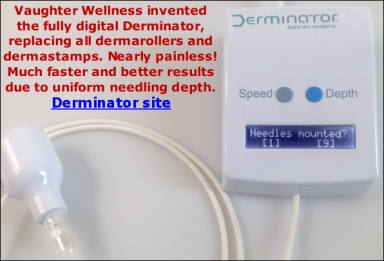The photo of hypopigmentation improved by needling is here:
https://http://www.owndoc.com/stretchmarks/dermarolling-before-and-after-photos-from-our-customers/ Intense Pulse Light (IPL) or lasers work on the same principle. It heats up the skin. The tissue absorbs light from the laser and that heats it up.
Everything in the skin absorbs laser light but some parts (for example dark colored parts) absorb it quicker, especially if specific wavelengths of light are used. Red pigments can be heated best with blue light, etc. Thus you can target hemoglobin in blood and destroy (seal) spider veins by heat. In laser epilation, you target melanin in the hairs and the heat will temporarily weaken the hair bulb. You can target tattoo pigment etc.
You can stimulate collagen production by slightly heating up the skin or use more energy and evaporate a layer of skin or just fractions of skin (Fraxel). The problem is that even if you target a specific part of the skin, the other parts heat up as well and in some unfortunate cases, the heat destroys for example melanocytes (pigment producing cells) as a collateral damage and you end up with hypopigmented spots or with scars and hyperpigmentaion when too much heat was used or the skin overreacted to heat.
To show you how fine is the line between positive and disastrous results, there were cases in laser epilation, when the treatment actually stimulated growth of thicker and coarser hairs in the area above the lip because to avoid potential burning of this sensitive area, the epilation laser was set too low and instead of paralyzing the hair bulbs by intensive heat, the bulbs were just slightly heated which actually stimulates them. Skin also contains melanin and setting the laser up too high can burn the skin.
Using enough energy to destroy or stimulate certain target but not too much in order not to burn the skin is very difficult and what works for one person can be too much or not enough for the other.
(BTW needling or dermarolling cannot help with an indentation after IPL or laser treatment if it is caused by receded (destroyed) fat. It can only improve an indentation caused by damaged skin)
Concerning your question:
If your hypopigmented spots are flat (no scars) the best is to roll the whole area with a 0.5 mm roller and needle the individual white spots with the single needle. You do not have to needle deep because melanocytes are at the bottom of the epidermis and that is rather shallow.
You should needle the white patches and also needle a little over the edges of the white patch to facilitate the migration of melanocytes from the surrounding normal skin into the white patch. When you complete several needlings, expose your patches to the sun because melanin is produced as a reaction to UV (provided there are melanocytes cell in the area to produce it).
Related forum postings:
https://http://forums.owndoc.com/dermarolling-microneedling/Hypopigmented-scar-treatment https://http://forums.owndoc.com/dermarolling-microneedling/Melanocytes-transfer-for-white-scars-and-hypopigmentation https://http://forums.owndoc.com/dermarolling-microneedling/Hypopigmented-post-tattoo-removal-scars




